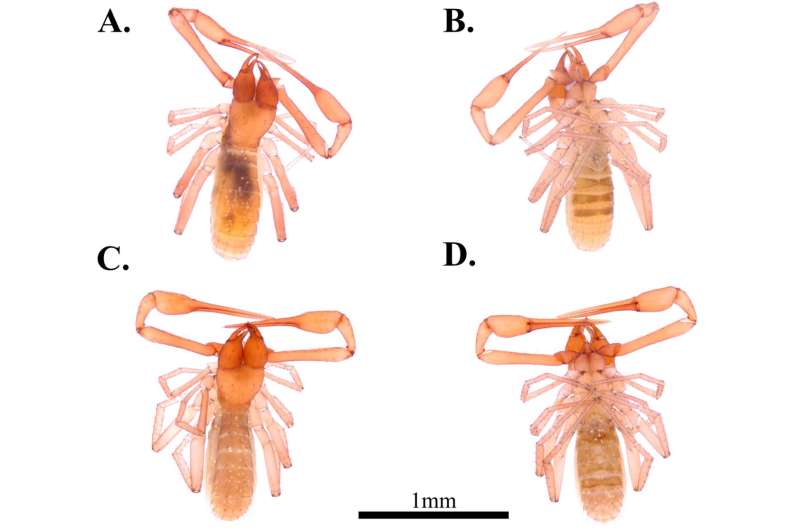Discovery of Four New Pseudoscorpion Species with Dragon-Like Jaws in Korean Caves

July 10, 2025 report
by Paul Arnold, Phys.org
contributing writer
edited by Gaby Clark, reviewed by Andrew Zinin
scientific editor
lead editor
This article has been reviewed according to Science X's editorial process and policies. Editors have highlighted the following attributes while ensuring the content's credibility:
fact-checked
peer-reviewed publication
trusted source
proofread
Scientists have discovered four new species of pseudoscorpions, blind cave-dwelling arachnids with dragon-like jaws. The subterranean creatures were found deep inside caves in South Korea by Kyung-Hoon Jeong and colleagues at Jeonbuk National University.
Dragon pseudoscorpions are small, usually around 1–3 millimeters long, with huge jaws relative to their body size. They are related to scorpions but do not have a sting in their tail. Nonetheless, they still look like formidable creatures.
While dragon pseudoscorpions exist in many parts of the world, in habitats such as tree hollows and tiny crevices, only five cave-dwelling pseudoscorpion species had previously been recorded in South Korea. This discovery, published in the journal PLOS One, brings that tally to nine.
The four new species are from the dragon pseudoscorpion family (Pseudotyrannochthoniidae: Spelaeochthonius) and are named S. dugigulensis, S. geumgulensis, S. magwihalmigulensis and S. yamigulensis. They were collected during field studies, preserved in ethanol, and identified through integrative taxonomy, which uses data from various sources, including genetics, ecology and morphology.
In common with many cave-dwelling species, the four pseudoscorpion species are pale in color, ranging from light orange to brown. Their dragon-like jaws help them to capture their prey in complete darkness.
Each of these new species is different from the others, both in their genetic makeup and in how they look. Additionally, each one is endemic to a single cave or karst system.
While the discovery of any new species is exciting, there's also some cause for concern. These newly identified pseudoscorpions, along with other cave-dwelling species and the caves themselves, face significant threats from climate change, pollution and habitat destruction.
To effectively conserve these subterranean ecosystems, we need to know more about them. As the researchers emphasize in their study, 'Discovering undescribed subterranean species is an important project for conserving and understanding the unveiled fauna of this dark ecosystem.'
This latest research also highlights just how much biodiversity could be hidden beneath South Korea's landscape. The country has more than a thousand caves, spread across two mountain ranges, the Taebaek Mountain Range and the Sobaek Mountain Range. Many of them have yet to be explored. This suggests that plenty more discoveries of species new to science are waiting to be found.
Scientists venturing into these caves not only hope their work will expand our knowledge but that it will also contribute to the important task of preserving these environments.
Written for you by our author Paul Arnold, edited by Gaby Clark, and fact-checked and reviewed by Andrew Zinin—this article is the result of careful human work. We rely on readers like you to keep independent science journalism alive. If this reporting matters to you, please consider a donation (especially monthly). You'll get an ad-free account as a thank-you.
More information: Kyung-Hoon Jeong et al, Four new species of dragon pseudoscorpions (Pseudoscorpiones: Pseudotyrannochthoniidae: Spelaeochthonius) from caves in South Korea revealed by integrative taxonomy, PLOS One (2025). DOI: 10.1371/journal.pone.0325375
Journal information: PLoS ONE
© 2025 Science X Network




